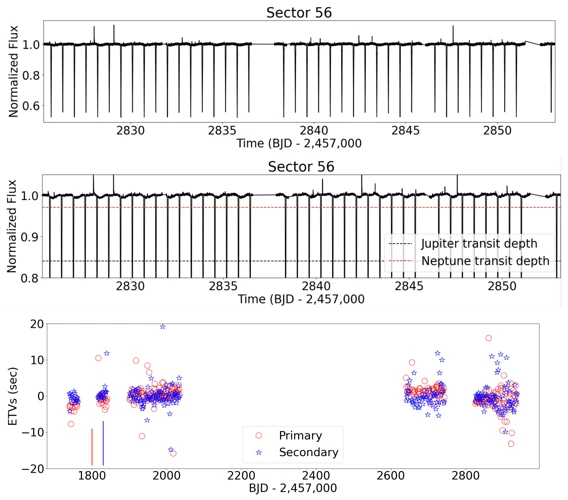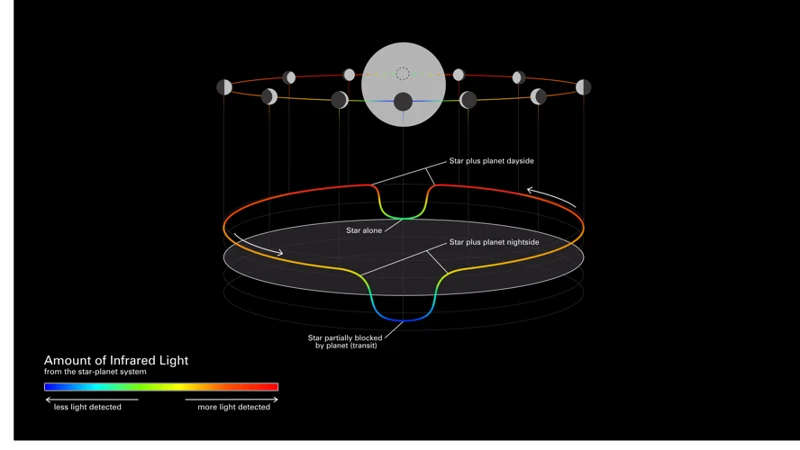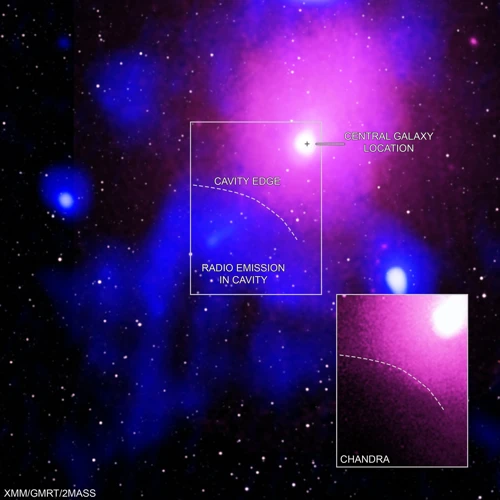Exploring the vast expanse of the universe has always captivated our imaginations, and one fascinating aspect of this exploration is the detection of exoplanets. Over the past few decades, astronomers have developed various techniques to uncover these distant worlds beyond our solar system. From the meticulous observations of transit photometry that detect subtle dips in a star’s brightness, to the analysis of radial velocity measurements that reveal the gravitational tugs of orbiting planets, scientists have made remarkable strides in understanding exoplanets. However, the search doesn’t stop there. This article delves into the intricacies of these detection methods and explores other innovative techniques like direct imaging, gravitational microlensing, and pulsar timing. Join us on this cosmic journey to unravel the mysteries of exoplanets.
Contents
- Transit Photometry
- Radial Velocity Method
- Other Detection Techniques
- Conclusion
-
Frequently Asked Questions
- 1. What is transit photometry?
- 2. How does transit photometry work?
- 3. What can transit photometry tell us about exoplanets?
- 4. What are the advantages of using transit photometry?
- 5. What are the limitations of transit photometry?
- 6. What is the radial velocity method?
- 7. How does the radial velocity method work?
- 8. What are the challenges of using the radial velocity method?
- 9. What other methods are used to detect exoplanets?
- 10. How does direct imaging help in exoplanet detection?
- References
-
Frequently Asked Questions
- How many exoplanets have been discovered so far?
- What is transit photometry?
- How does transit photometry work?
- What are the advantages of transit photometry?
- What are the limitations of transit photometry?
- What is the radial velocity method?
- How does the radial velocity method work?
- What are the challenges of the radial velocity method?
- What are other methods used to detect exoplanets?
- What is the significance of exoplanet detection methods?
- References
- Read More
Transit Photometry

Transit photometry is a powerful method used to detect exoplanets by observing the slight decrease in a star’s brightness when a planet passes in front of it. This technique relies on precise measurements of the star’s light intensity over time. During a transit, the exoplanet blocks a small fraction of the star’s light, causing a noticeable dip in brightness. By carefully analyzing and monitoring these variations, astronomers can determine various properties of the exoplanet, such as its size, orbit, and even its atmospheric composition in some cases. One advantage of transit photometry is its ability to detect relatively small exoplanets, including those in the habitable zone of their star, where conditions could potentially support life. However, this method does have limitations, such as the requirement of favorable alignment between the star, exoplanet, and the observer on Earth. Nonetheless, transit photometry has played a vital role in expanding our knowledge of exoplanet systems and the diversity of planetary formations throughout the universe. (source)
Principles of Transit Photometry
Principles of Transit Photometry:
1. Light Curve Analysis: The key principle of transit photometry is the analysis of light curves. When an exoplanet passes in front of its host star, it causes a temporary decrease in the star’s brightness. By monitoring and recording these changes in light intensity over time, astronomers can construct a light curve. This curve represents the planet’s transit, showing the duration and depth of the brightness dip.
2. Periodicity and Precise Timing: Transit photometry relies on the periodic nature of exoplanet transits. By observing multiple transits and measuring the time interval between them, scientists can determine the orbital period of the exoplanet. The precision of timing is crucial to accurately establish the orbital properties and predict future transits.
3. Planet-to-Star Size Ratio: An essential principle is determining the size of the exoplanet relative to its host star through transit photometry. The depth of the brightness dip in the light curve provides information about the planet’s radius compared to the star’s radius. By using mathematical calculations and considering the star’s properties, astronomers can estimate the exoplanet’s size.
4. Exoplanet and Star Alignment: Successful detection of exoplanets using transit photometry relies on a fortuitous alignment between the exoplanet, its host star, and Earth. For a transit to occur, the planet must cross in front of the star as viewed from our perspective. This alignment is crucial for capturing the temporary decrease in brightness and collecting data to analyze.
5. Confirmatory Techniques: To confirm the presence of an exoplanet detected through transit photometry, additional observations are often required. These can include follow-up observations, such as radial velocity measurements or analysis using other detection methods like direct imaging or gravitational microlensing. These confirmatory techniques help validate the transit photometry results and provide a more comprehensive understanding of the exoplanet system.
Transit photometry provides valuable insights into the characteristics and properties of exoplanets. By analyzing light curves and applying these principles, scientists have made significant discoveries in our quest to understand the diversity and formation of exoplanets. (source)
Advantages and Limitations
Advantages:
– High Sensitivity: Transit photometry is highly sensitive to small changes in star brightness, making it capable of detecting even tiny exoplanets. This sensitivity allows astronomers to study a wide range of exoplanets, including those comparable in size to Earth or even smaller.
– Statistical Analysis: The data collected from transit photometry can be statistically analyzed to uncover patterns and trends among exoplanet populations. This analysis provides valuable insight into the frequency of different types of exoplanets and their distribution in the galaxy.
– Atmospheric Studies: Transit photometry enables scientists to study exoplanet atmospheres by examining the slight changes in the star’s light as it passes through the planet’s atmosphere. This information can reveal the presence of certain gases, like hydrogen or methane, and provide clues about an exoplanet’s potential habitability.
Limitations:
– Limited Orbital Alignment: One of the main limitations of transit photometry is the requirement of a specific alignment between the star, exoplanet, and the observer on Earth. This means that only a small fraction of exoplanets have an orbital inclination that allows for detection through this method.
– Biased Towards Large Planets: Transit photometry tends to be biased towards detecting larger exoplanets that cause more significant drops in star brightness. Smaller exoplanets are more challenging to detect using this method, making it less effective for studying Earth-sized or smaller worlds.
– False Positives: Transit photometry can sometimes produce false positives, where other phenomena, such as binary star systems or instrumental noise, mimic the characteristics of an exoplanet transit. This requires careful analysis and confirmation through additional observations.
Despite these limitations, transit photometry has proven to be a valuable tool in the detection and characterization of exoplanets. Its sensitivity and ability to study exoplanet atmospheres make it an indispensable technique in the ever-expanding field of exoplanet research. (source)
Radial Velocity Method

The radial velocity method, also known as the Doppler spectroscopy method, is another essential technique that enables astronomers to detect exoplanets. This method relies on the principle that a star wobbles slightly as it is influenced by the gravitational pull of an orbiting planet. By analyzing the Doppler shift in the star’s spectrum, scientists can determine changes in its radial velocity, which provide crucial information about the presence and properties of the exoplanet. The radial velocity method is particularly effective for detecting massive exoplanets that are close to their host stars. This technique has revolutionized the field of exoplanet detection and has allowed scientists to uncover numerous exoplanets, expanding our understanding of planetary systems in the universe. However, the radial velocity method has its challenges, including the difficulty of detecting smaller, distant, and lower-mass exoplanets. Nonetheless, it remains a valuable tool in the pursuit of discovering and characterizing exoplanets.
Explaining Radial Velocity Measurements
Radial Velocity Measurements, also known as the Doppler Method, is another prominent technique used in the detection of exoplanets. This method relies on the principle that a star and its orbiting planet(s) both exert gravitational forces on each other. When a star is orbited by a planet, the planet’s gravitational pull causes the star to wobble ever so slightly. The wobbling motion induces a Doppler shift in the star’s light, resulting in a subtle change in its observed spectrum. By analyzing these spectral shifts, astronomers can deduce the presence of an exoplanet and gather crucial information about it, such as its mass and orbital characteristics. This method is particularly effective for detecting massive exoplanets that are closer to their host stars, as their gravitational influence is more pronounced. Additionally, radial velocity measurements can provide insights into the eccentricity of an exoplanet’s orbit and the presence of additional planets in the system. However, this technique has some limitations, including its inability to detect exoplanets with orbital planes that are nearly perpendicular to the line of sight from Earth. Despite these constraints, radial velocity measurements have proven to be a valuable tool in the ongoing quest to unravel the mysteries of exoplanetary systems.
Challenges and Applications
When it comes to the radial velocity method, there are several challenges that astronomers face. One major challenge is the presence of stellar activity, such as sunspots or flares, which can mimic the gravitational pull of an exoplanet and introduce inaccuracies in measurements. Scientists have developed sophisticated techniques to differentiate between stellar activity and true exoplanet signals, but this remains a complex task. Additionally, the radial velocity method is more sensitive to large planets that are close to their host stars. This means that smaller, more distant planets may be more challenging to detect using this method alone.
Despite these challenges, the radial velocity method has proven to be highly valuable in the field of exoplanet detection. It has been instrumental in identifying a wide range of exoplanets, including hot Jupiters, super-Earths, and even some Earth-sized planets. By measuring the radial velocity variations of a star, astronomers can determine important properties of the exoplanet, such as its mass, orbital period, and eccentricity. This information provides crucial insights into the dynamics and formation of exoplanetary systems.
The applications of the radial velocity method go beyond detecting exoplanets. It has also been used to study binary star systems and determine their masses, as well as search for hidden stellar companions. This method can be utilized to study the long-term stability of planetary systems and investigate the presence of additional planets in the system that may not be detectable through other techniques. By combining the radial velocity method with other detection methods like transit photometry and direct imaging, astronomers can obtain a more comprehensive understanding of exoplanetary systems and their characteristics.
While the radial velocity method presents its own set of challenges, it has proved to be a valuable tool in the detection and characterization of exoplanets. Its applications extend beyond exoplanet research, contributing to our understanding of binary star systems and planetary dynamics. With ongoing advancements in technology and data analysis techniques, the radial velocity method continues to play a crucial role in unraveling the mysteries of the universe and expanding our knowledge of exoplanetary systems.
Other Detection Techniques

Aside from transit photometry and radial velocity, there are several other techniques used for detecting exoplanets. One method is direct imaging, which involves capturing images of exoplanets by blocking out the light of the star they orbit. Although challenging due to the vast difference in brightness between the star and the planet, direct imaging provides valuable information about the planet’s atmospheric composition and characteristics. Another technique is gravitational microlensing, where the gravitational field of a massive object magnifies the light of a background star, revealing the presence of a planet within the field. Pulsar timing is yet another method, relying on the precise timing of the radio signals emitted by pulsars to detect variations caused by the gravitational pull of orbiting planets. These alternative methods offer unique insights into the exoplanet population, complementing the information obtained from transit photometry and radial velocity measurements. (source)
Direct Imaging
Direct imaging is a fascinating technique that involves capturing actual images of exoplanets. Unlike other detection methods, which rely on indirect observations of a planet’s effects on its host star, direct imaging allows astronomers to directly observe exoplanets as isolated objects. This method is particularly useful for studying the atmospheres of exoplanets, as it enables the analysis of their composition and potentially the presence of elements necessary for life. Direct imaging is typically performed using advanced telescopes equipped with adaptive optics systems. These systems help mitigate the blurring effects of Earth’s atmosphere, allowing for sharper and more detailed images. The challenge with direct imaging is that exoplanets are incredibly faint compared to their host stars, making them difficult to detect. To overcome this, astronomers use coronagraphs or other techniques to block out the star’s bright light, enabling the detection of the much dimmer exoplanets. Despite the challenges, direct imaging has provided valuable insights into the diversity of exoplanets, ranging from large gas giants to potentially Earth-like rocky planets. It has also paved the way for future missions aiming to directly image habitable exoplanets and search for signs of life beyond our solar system.
Gravitational Microlensing
Gravitational Microlensing is an innovative technique used to detect exoplanets by observing the amplified brightness of a background star when a foreground star passes between it and the observer. This phenomenon occurs due to the gravitational bending of light by the foreground star’s gravitational field. When the foreground star has a planet orbiting around it, the planet’s gravitational field further magnifies the effect, creating a distinct microlensing event.
During a microlensing event, the background star’s light undergoes a temporary increase in brightness, providing valuable information about the presence and characteristics of the exoplanet. The duration of the microlensing event depends on the mass of the planet and the relative alignment of the stars. Higher mass planets produce longer microlensing events, making it possible to determine the mass of the exoplanet.
Unlike transit photometry or the radial velocity method, gravitational microlensing does not require the observer to be in the same plane as the exoplanet’s orbit. This means that this technique is particularly sensitive to detecting planets that are further away from their host stars. However, the microlensing events are rare and unpredictable, making it challenging to observe them in real-time.
Gravitational microlensing has been successful in identifying distant and massive exoplanets, including gas giants similar to Jupiter. It also provides insights into the frequency of exoplanets in our galaxy, as the microlensing events can be used to estimate the abundance of planets in different regions of our Milky Way. This method complements other detection techniques and contributes to our ever-growing understanding of exoplanetary systems.
Pulsar Timing
Pulsar timing is a unique and intricate method of detecting exoplanets that involves studying the regular pulses emitted by pulsars, which are highly magnetized, rotating neutron stars. By monitoring the precise timing of these pulses, astronomers can detect any minute anomalies caused by the gravitational pull of an orbiting exoplanet. Here are some key points to understand about pulsar timing:
1. Principle: The principle behind pulsar timing relies on the fact that a pulsar’s pulses arrive at Earth with extreme regularity. However, the gravitational influence of an exoplanet in orbit around the pulsar can cause small deviations in the arrival time of the pulses. By analyzing these timing irregularities, astronomers can infer the presence and properties of the exoplanet.
2. Observations and Analysis: Pulsar timing requires long-term, high-precision observations of pulsar signals to accurately measure the arrival times of the pulses. These measurements are compared to a predicted pulse arrival time model to identify any discrepancies. The timing residuals, which are the differences between the observed and predicted arrival times, can reveal the gravitational effects exerted by exoplanets.
3. Challenges: Pulsar timing is an intricate process that presents several challenges. One major challenge is distinguishing the timing irregularities caused by exoplanets from other sources of timing noise, such as pulsar intrinsic variability or the presence of a binary companion. These complications necessitate careful analysis and statistical techniques to ensure accurate planet detection.
4. Applications: Pulsar timing is particularly well-suited for detecting massive exoplanets in close orbits around pulsars. These exoplanets, often referred to as “pulsar planets” or “pulsar companions,” can have unique properties compared to planets orbiting main-sequence stars. Pulsar timing has also been influential in testing the theory of general relativity and studying the dynamics of compact binary systems.
Pulsar timing is a fascinating method that expands our understanding of exoplanetary systems and offers valuable insights into the nature of neutron stars and their surroundings. The precise timing measurements and careful analysis involved in this technique contribute to the ongoing quest of exploring the vast expanse of our universe.
Conclusion

In conclusion, understanding the methods used in detecting exoplanets provides valuable insights into the vast expanse of the universe and our place within it. The techniques discussed in this article, including transit photometry and the radial velocity method, have revolutionized our understanding of exoplanets and their characteristics. Transit photometry has allowed us to detect small exoplanets and study their properties, while the radial velocity method has provided valuable information about their mass and orbital parameters. However, it is crucial to acknowledge that these methods have their limitations, and they may not be suitable for detecting all types of exoplanets. Other innovative techniques, such as direct imaging, gravitational microlensing, and pulsar timing, offer alternative approaches to explore and study exoplanets. Each method contributes to our understanding of these distant worlds and expands our knowledge of planetary systems beyond our own. As technology continues to advance, it is likely that new detection methods will emerge, pushing the boundaries of our understanding even further. Exciting discoveries lie ahead as scientists continue to refine and develop these techniques, making exoplanet detection an ever-evolving field of study. By integrating data from different detection methods and combining the insights gathered, astronomers can paint a more comprehensive picture of the countless exoplanets that exist in our universe. (source)
Frequently Asked Questions

1. What is transit photometry?
Transit photometry is a method used to detect exoplanets by observing the decrease in a star’s brightness when a planet passes in front of it.
2. How does transit photometry work?
In transit photometry, astronomers measure the change in a star’s brightness over time. When a planet transits in front of the star, it blocks a small fraction of its light, causing a detectable dip in brightness.
3. What can transit photometry tell us about exoplanets?
Transit photometry can provide valuable information about exoplanets, including their size, orbit, and even the composition of their atmospheres in some cases.
4. What are the advantages of using transit photometry?
One advantage of transit photometry is its ability to detect relatively small exoplanets, including those in the habitable zone of their star, where the conditions for life may exist.
5. What are the limitations of transit photometry?
Transit photometry requires a favorable alignment between the star, exoplanet, and the observer on Earth, limiting its applicability to systems with specific orientations. Additionally, it may be challenging to distinguish transit signals from other sources of variability in star brightness.
6. What is the radial velocity method?
The radial velocity method, also known as the Doppler method, is a technique used to detect exoplanets by measuring variations in the star’s radial velocity caused by the gravitational tug of an orbiting planet.
7. How does the radial velocity method work?
By observing the slight shifts in a star’s spectral lines towards shorter or longer wavelengths, astronomers can infer the presence of an exoplanet and calculate its mass and orbit characteristics.
8. What are the challenges of using the radial velocity method?
The primary challenge of the radial velocity method is that it is more suitable for detecting massive exoplanets located closer to their host stars. Small or distant exoplanets might not produce a clear enough signal to be detected.
9. What other methods are used to detect exoplanets?
Apart from transit photometry and the radial velocity method, astronomers use techniques like direct imaging, gravitational microlensing, and pulsar timing to detect exoplanets.
10. How does direct imaging help in exoplanet detection?
Direct imaging involves capturing images of exoplanets by blocking the light from their host star. This technique is useful for observing large, young exoplanets that are far from their star.
References
Frequently Asked Questions

How many exoplanets have been discovered so far?
As of now, scientists have discovered over 4,000 exoplanets.
What is transit photometry?
Transit photometry is a method used to detect exoplanets by measuring the dip in the brightness of a star when a planet passes in front of it.
How does transit photometry work?
Transit photometry works by observing the light emitted from a star and monitoring any periodic dips in brightness caused by a planet passing between the star and the observer.
What are the advantages of transit photometry?
Transit photometry is a highly effective method for detecting exoplanets and can provide valuable information about the size, orbit, and atmosphere of these planets.
What are the limitations of transit photometry?
Transit photometry is limited to detecting exoplanets that pass directly in front of their host stars from the observer’s perspective. It may also be affected by false positives and other observational challenges.
What is the radial velocity method?
The radial velocity method is a technique used to detect exoplanets by measuring the tiny changes in a star’s velocity as it is pulled by the gravitational force of orbiting planets.
How does the radial velocity method work?
The radial velocity method works by analyzing the Doppler shift in a star’s spectral lines caused by its motion towards or away from Earth due to the gravitational tug of an orbiting exoplanet.
What are the challenges of the radial velocity method?
The radial velocity method is limited by the sensitivity of measurement instruments and the presence of stellar activity such as spots, flares, and pulsations, which can interfere with accurate planet detection.
What are other methods used to detect exoplanets?
Other methods include direct imaging, which involves taking actual pictures of exoplanets, gravitational microlensing, which detects the distortion of light from a distant star due to the gravitational influence of an exoplanet, and pulsar timing, which uses the precise timing of radio pulses emitted by pulsars to detect the gravitational effects of exoplanets.
What is the significance of exoplanet detection methods?
Exoplanet detection methods enable scientists to identify and study planets beyond our solar system, providing insights into the diversity of planetary systems, the potential for habitable environments, and the origins of our own solar system.
References
- Methods used to detect exoplanets
- How We Find and Characterize – Exoplanet Exploration – NASA
- Exoplanet detection methods – ESA Science & Technology







